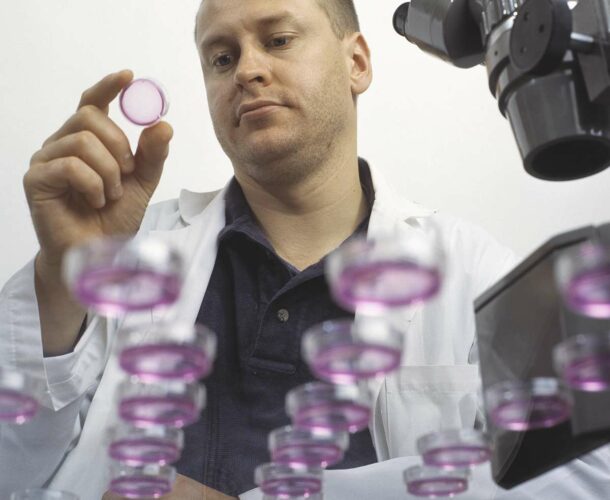Communicating chemicals
Blood cells are great communicators, continuously relaying messages.
They communicate through tiny chemical messengers called cytokines. Cytokines – sometimes referred to as cell signalling hormones – send messages that tell other cells when to activate, when to grow and divide, and when to die, often in response to a potential danger such as infection.
A lifelong interest
Doug Hilton became interested in cytokines as an undergraduate student.
“I was fascinated by blood cells and how they communicate,” Hilton says.
“I came to the Walter and Eliza Hall Institute to work with Nick Nicola because he was doing some really interesting work with cytokines.”
Cytokines are incredibly potent molecules. In their famous discovery of CSFs, Professor Don Metcalf and Professor Nick Nicola showed that the hormones were so potent just one molecule in a million was enough to stimulate white blood cells to grow.
During his PhD, Hilton and Nicola identified another potent cytokine called leukaemia inhibitory factor (LIF).
But by the time Hilton came back from an overseas postdoc, a new question was plaguing him.
“A lot of work had been done to unearth the signals that switch on signalling, the beneficial effects of cytokines and also their side-effects, such as chronic inflammation and autoimmune disease.”
But almost nothing was known about how these signals were halted.
“It got us thinking: how does the blood cell recognise that it should stop responding to that signal?
“Many people in the field assumed there must be negative feedback signals that tempered cytokine action, but we decided to actually go and find them.”
Negative feedback
With talented postdoc Dr Robyn Starr, Hilton set out to find these elusive proteins.
“Very quickly we pulled out an extraordinarily powerful inhibitor of signalling and showed that it was part of a family of negative feedback regulator proteins,” Hilton says. “It was just one of those magic moments.”
They had discovered a major new family of negative regulators, called SOCS (Suppressors of Cytokine Signalling).
“SOCS help to limit the magnitude and duration of that particular cell’s response to the cytokine. They prevent the detrimental effects of excessive blood cell signalling, such as occurs in chronic inflammation,” Hilton says.
Starr then showed that one type of SOCS (called SOCS-1) switched off the cell’s response to a critical cytokine called interferon.
“Interferon is released when there is an infection, and it is absolutely essential for the immune response,” Hilton says. “Without SOCS-1, the interferon signal to the cell is too ‘loud’ and too long, and the result is severe tissue damage and autoimmune disease.”
SOCS: from cancer to immune disorders
Hilton and his colleagues quickly identified another six SOCS proteins, all with different roles to play in blood cell signalling and in disease. “This includes cancers, rheumatoid arthritis, neurological diseases, inflammatory bowel disease, asthma and obesity,” Hilton says.
In a 2004 interview with Australian Life Scientist, Hilton talked of the “intriguing potential” of the molecules.
“SOCS-1, for example, plays a role in controlling interferon responses, so could be useful as a target for drugs to treat chronic viral diseases and autoimmune diseases such as multiple sclerosis and diabetes, while SOCS-2 is involved in growth hormone signalling, and SOCS-3 in controlling G-CSF and erythropoietin.”
Groups at the Walter and Eliza Hall Institute are now looking at the role of SOCS proteins in diseases such as rheumatoid arthritis, influenza, blood disorders and cancers.
“Controlling the activity of these cellular ‘off’ switches could lead to major advances in treating human diseases,” Hilton says.
New treatment for blood disease
Some types of leukaemia and, in particular, myeloproliferative disorders (MPDs) are caused by over-active signalling in blood cells.
Myeloproliferative disorders, such as polycythemia vera and myelofibrosis, are serious blood disorders in which an excessive number of blood cells accumulate in the bone marrow, which can lead to bone marrow failure.
Jeff Babon is working with Nick Nicola to find ways of enhancing or dampening the immune response by targeting SOCS-3.
“New drugs could be made that treat cancers and blood disorders by better understanding how the body controls and maintains the blood and immune systems,” Babon says.
In 2011, Babon and Nicola made an important discovery about how SOCS-3 binds to a molecule called JAK2 (Janus kinase-2).
“Drugs that target JAK2 do exist, but they are not specific enough and cause significant side-effects that make them undesirable for use in humans,” Babon says.
“We decided to let nature show us how JAK2 and SOCS-3 interact in order to learn how SOCS-3 normally halts JAK2 activity. We were surprised to find that SOCS-3 binds to a part of the JAK2 protein that is not targeted by current therapies.
“We are now looking to develop drugs that exploit this new site as a drug target, and we think the drugs will be much more specific, and hence more attractive as a human drug, than any other currently in clinical trials for inhibiting JAK2.”
“In the future, this discovery could lead to new treatments for leukaemias and MPDs, as well as inflammatory diseases such as arthritis.”






